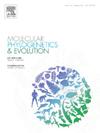宿主群落的系统发育关系和物种组成影响冠状病毒在同域蝙蝠中的传播
IF 3.6
1区 生物学
Q2 BIOCHEMISTRY & MOLECULAR BIOLOGY
引用次数: 0
摘要
自2002年出现严重急性呼吸系统综合症(SARS)以来,蝙蝠已被认为是多种冠状病毒(cov)的重要宿主。尽管对蝙蝠冠状病毒的广泛地理传播进行了广泛的研究,但在了解同域蝙蝠群落内的传播动态方面存在显着差距。利用系统地理学贝叶斯统计框架,我们在一个四个蝙蝠栖息洞穴共存且冠状病毒持续传播的地区研究了冠状病毒的传播模式及其决定因素。我们的研究结果表明,冠状病毒的两个亚属α-冠状病毒和β-冠状病毒在不同的时间主导不同的蝙蝠洞。值得注意的是,β-冠状病毒在主要宿主鼻蝗科蝙蝠之间的跨种传播更为频繁。宿主物种间的系统发育距离是病毒跨物种传播的关键影响因素,而同居时间和共用洞穴的宿主数量对病毒跨物种传播的影响不显著。此外,我们强调在栖息洞穴中物种组成的相似性对蝙蝠冠状病毒的洞穴间传播至关重要,而不是洞穴之间的距离。这些结果为同域蝙蝠群落中蝙蝠冠状病毒的复杂传播动力学提供了新的见解。本文章由计算机程序翻译,如有差异,请以英文原文为准。

Phylogenetic relationships and species composition of host community influence the transmission of coronaviruses in sympatric bats
Since the emergence of Severe Acute Respiratory Syndrome (SARS) in 2002, bats have been recognized as important reservoirs of diverse coronaviruses (CoVs). Despite extensive research on the broad geographic transmission of bat CoVs, there is a notable gap in understanding the transmission dynamics within sympatric bat communities. Using a phylogeographic Bayesian statistical framework, we examined CoV transmission patterns and their determinants in a region where four bat roosting caves coexist and CoVs circulate persistently. Our findings reveal that two subgenera of CoVs, α-CoVs and β-CoVs dominate different bat caves at varying times. Notably, β-CoVs show more frequent cross-species transmission events among the dominant reservoir hosts, bats of Rhinolophidae. Phylogenetic distance between host species emerges as the key influence factor of viral cross-species transmission, whereas cohabitation duration and the number of hosts sharing caves do not significantly influence viral transmission. In addition, we emphasize that the compositional similarity of species in the roosting caves is critical for the inter-cave transmission of bat-CoVs, rather than the distance between cave. These results provide novel insights into the complex transmission dynamics of bat CoVs within sympatric bat communities.
求助全文
通过发布文献求助,成功后即可免费获取论文全文。
去求助
来源期刊
CiteScore
7.50
自引率
7.30%
发文量
249
审稿时长
7.5 months
期刊介绍:
Molecular Phylogenetics and Evolution is dedicated to bringing Darwin''s dream within grasp - to "have fairly true genealogical trees of each great kingdom of Nature." The journal provides a forum for molecular studies that advance our understanding of phylogeny and evolution, further the development of phylogenetically more accurate taxonomic classifications, and ultimately bring a unified classification for all the ramifying lines of life. Phylogeographic studies will be considered for publication if they offer EXCEPTIONAL theoretical or empirical advances.

 求助内容:
求助内容: 应助结果提醒方式:
应助结果提醒方式:


